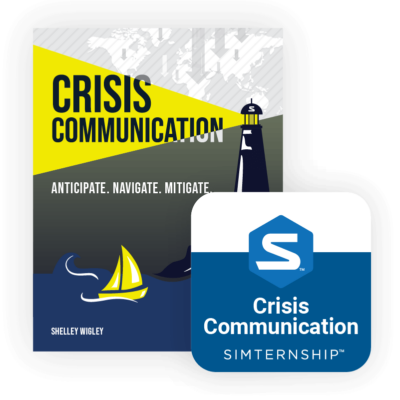All-new
Strategic Communication Essentials
INCLUDES A COURSE SYLLABUS WITH
Strategic Communication Essentials Courseware
Turnkey Resources to Teach Strategic Communication
Keep your curriculum current with the “Strategic Communications” courseware! With an authoritative text and hundreds of resources for educators, you'll have all the tools you need to introduce students to the communication ecosystem and infrastructure, research and techniques, master plans, and more.
The courseware explores the structure of the communication industry and encourages students to apply principles to real-world scenarios. Students will gain an understanding of the systems approach and explore writing, budgeting, funding master plans, and more. This courseware goes beyond a regular textbook, as it contains auto-graded quizzes, detailed lesson plans, engaging assignments, and other resources that will help you stay organized and save time.

*Click to see the annotated table of contents.
CHAPTER 1: Background, Theory, and Definitions
Define and discuss the evolution of strategic communication.
CHAPTER 2: Disciplines, Specialties, and Careers
Explore strategic communication disciplines, specialties, and careers.
CHAPTER 3: Goals, Objectives, and Metrics
Understand differences among goals, objectives, key performance indicators (KPIs), and metrics.
CHAPTER 4: Brand Theory and Strategy
Discover the shared essence of brand theory and strategic communication, while gaining valuable insights into how individuals and organizations can leverage their brand identity.
CHAPTER 5: Critical Audience Theory and Strategy
Define the strategic communication terms, publics, constituencies, stakeholders, and the four critical audience mega categories.
CHAPTER 6: Media Theory and Strategy
Describe the strengths and weaknesses of the four classifications of media.
CHAPTER 7: Message Theory and Strategy
Define messaging and deconstruct message theory.
CHAPTER 8: Research Methods and Techniques
Identify research tools available to communication managers, advertising agencies, and PR firms.
CHAPTER 9: The SC Ecosystem and Infrastructure
Describe the SC Ecosystem.
CHAPTER 10: Gearing Up for the Master Plan
Examine the processes deployed by the SC Task Force.
CHAPTER 11: Writing, Budgeting, and Funding the Master Plan
Explain the Master Plan writing process and Five Cs.
CHAPTER 12: Moving from Plan to Action SC ROI
Explain the important considerations for preparing strategic communication.
CHAPTER 13: Interpersonal / Internal / Organizational (IPIO) Communication
Describe the IPIO communication environment and explain interpersonal, internal, and organizational communication channels.
CHAPTER 14: Issues Management and Crisis Communication
Examine the Issues Management and Crisis Communication Continuum.
CHAPTER 15: Legal and Ethical Issues
Differentiate between law and ethics as it pertains to strategic communication.
CHAPTER 1 Learning Objectives
- Evaluate the definition of strategic communication
- Discuss the evolution of the concept of strategic communication and its core theories
- List the benefits of strategic communication for any organization
- Discuss the two ways strategic communication and integrated marketing communication differ
- Describe the role outside council provides to SC initiatives of an organization
CHAPTER 2 Learning Objectives
- Recognize the strategic communication disciplines
- Recognize the strategic communication specialties
- Recognize the strategic communication careers
- Apply the strategic communication disciplines and specialities to the practice
- Describe the four media disciplines
- Apply the four media disciplines to strategic communication specialties
CHAPTER 3 Learning Objectives
- Distinguish between communication goals and objectives
- Classify behavior change goals, objectives, and metrics
- Classify attitude change goals, objectives, and metrics
- Classify knowledge change goals, objectives, and metrics
- Evaluate CE and Brand “trustworthiness” as it relates to critical audiences
- Explain the usefulness of the StratComm Scorecard
- Apply “trust” as a StratComm Scorecard metric
CHAPTER 4 Learning Objectives
- Summarize the basics of brand theory
- Discuss the benefits of a brand
- Recognize the concept of “four-star brand status”
- Defend the importance of brand and message consistency
- Justify the Brand Facets Collective
- Differentiate the characteristics of tangible, cognitive, and experiential
- Define selected brand terms
- Describe how positioning is used as a branding tool
CHAPTER 5 Learning Objectives
- Define the strategic communication terms, publics, constituencies, and stakeholders
- Define the four critical audience mega categories
- Discuss the importance of knowing the target audience in the context of strategic communication
- Apply the four concepts of audience profiles
- Describe the concept of audience personification
- Categorize audience types
- Distinguish audience segmentation from audience aggregation
CHAPTER 6 Learning Objectives
- Describe the PESO framework
- Define paid media
- Discuss paid media goals and measurement, strengths, and weaknesses
- Define earned media
- Discuss earned media goals and measurement, strengths, and weaknesses
- Define shared media
- Discuss shared media goals and measurement, strengths, and weaknesses
- Define owned media
- Discuss owned media goals and measurement, strengths, and weaknesses
- Apply the PESO classification system to a strategic communication initiative
CHAPTER 7 Learning Objectives
- Define message and messaging
- Deconstruct message theory
- Discuss message forms and structures
- Distinguish between message and meaning
- Apply multi-level competition theory
- Describe the message development process
- Explain the importance of emotion in message strategy
- Explain the relevance of storytelling
- Describe message processing and interpretation from the receiver’s point of view
- Summarize the four steps of persuasion
- Explain the concept of non-persuasive communication
CHAPTER 8 Learning Objectives
- Compare fundamental versus applied research
- Differentiate between primary and secondary research
- Differentiate between qualitative versus quantitative research
- Apply the Continuum of Qualitative and Quantitative Research
- Recognize the 10 types of research techniques
- Describe top management’s involvement in research
- Describe the challenges involved in research funding and approval
CHAPTER 9 Learning Objectives
- Describe the SC Ecosystem
- Explain how the SC Ecosystem works
- Recognize the components of the SC ecosystem
- Describe the SC infrastructure
- Recognize the players that make the SC process work
CHAPTER 10 Learning Objectives
- Apply critical audience theory to a communicating entity (CE) or Brand
- Identify a CE or Brand’s critical audiences by comprehensive classification
- Define and describe critical audiences
- Craft insights related to identified critical audiences
- Describe critical audience perceptions and expectations of the CE or Brand
- Describe the CE or Brand’s needs, aspirations
- Reconcile critical audience perceptions with CE or Brand aspirations
- Write strategic communication objectives
- Create StratComm Scorecard metrics
CHAPTER 11 Learning Objectives
- Discuss the purpose of each master plan component
- Explain the Master Plan writing process
- Describe the 5 Cs
- Apply the Master Plan Checklist
- Explain the type of funding sources available for SC
- Describe the make-up of a SC budget
- Evaluate SC budget methods
- Describe best practices for presenting the SC Master Plan and budget
- Explain the role of the CCO in the budgeting and funding process
- Explain the role of procurement and purchasing in the SC plan
CHAPTER 12 Learning Objectives
- Explain the important considerations for preparing SC communication
- Recognize the nine standard SC documents
- Identify the 18 Milestones in the path of a campaign, start to finish
- Define communication returns
- Discuss how returns can be expressed
- Describe the four ways returns can be articulated in the annual strategic communication ROI report
CHAPTER 13 Learning Objectives
- Describe the IPIO communication environment
- Explain interpersonal / internal / organizational communication channels
- Discuss organizational culture and its Impact on IPIO communication
- Associate leadership style to its impact on IPIO communication
- Define group dynamics and its Impact on IPIO communication
- Associate Strategic Communication Task Force group cognition to its impact on IPIO communication
- Associate media selection to its impact on IPIO communication
CHAPTER 14 Learning Objectives
- Discuss the Issues Management and Crisis Communication Continuum
- Discuss the Continuum of Risk and Preparedness Communication
- Explain “Who Controls the Language?”
- Define the The “Five M’s” of Issues Management and Crisis Communication
- Assess the Guiding Principles of issues management and crisis communication
CHAPTER 15 Learning Objectives
- Differentiate between law and ethics as it pertains to strategic communication
- Define the governmental agencies that regulate law as it pertains to free speech
- Discuss ethical communication concerns for the communicating entity, outside council, media, suppliers and vendors
- Apply ethics for strategic communication practitioners in professional and personal life
The courseware’s materials make teaching strategic communication essentials easier for you and more engaging for students. The following resources are included:
- Auto-graded quizzes for each chapter with 92+ exam questions
- 30 lecture slide decks
- 30 lesson plans
- 15 assignments
- 1 comprehensive term project
- 8 week course schedule & 15 week course schedule
- Real-world examples
- Sample syllabus and course calendars
- Cumulative glossary for student reference
- LMS integration with Stukent platforms
Expand your
Definition of Courseware
Updated every year
With lifetime access for students.
100+ resources
Includes case studies, lecture slides, exams, lesson plans and more.
The Stukent Support Team
With a 96% customer service satisfaction rating.

ABOUT
THE AUTHORS

Don Dickinson
After an illustrious career in the advertising agency business, Don Dickinson spent the last 15 years of his career as the director of the advertising management program at Portland State University School of Business. Under his leadership, the program grew three-fold and achieved national stature in student ad competitions.
Together, Craig Davis and Don have authored three other advertising and public relations textbooks, including:
- “The Media Strategy and Planning Workbook,” 3rd ed., 2020
- “The New Account Manager,” 3rd ed., 2018
- “The Advertising and PR Account Management Workshop,” 2017
In addition to the books listed above, Don authored a landmark book, “Advertising Metrics and Return On Investment,” published in 2011 by the prestigious American Association of Advertising Agencies (4As), exclusively for its member agencies.

Craig Davis
Craig Davis is a professor at Ohio University. He teaches introduction to advertising and public relations, strategic communication research, account management, account planning, media, and campaign management courses and more. He has worked for Saatchi & Saatchi New York and Arnold Worldwide New York, holding important integrated and digital positions.
Davis has taught graduate and undergraduate courses at Pace University, West Virginia University, Clemson University, BBT Japan, and Bond University. He is also an expert in case writing pedagogy.
Hands-on Learning without the Hassle
Stukent Simternships integrate with your favorite LMS platforms
Single Sign-on
Grade Book Syncing
Deep Linking
Rostering


Related Courses
Help educators help students help the world
Stukent Keeps Academia Current



